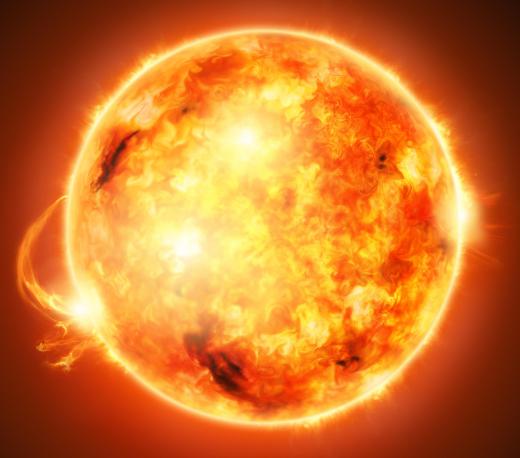What is Solar Radiation?
Solar radiation is the full spectrum of light given off by the sun. It includes visible light and all other frequencies of radiation on the electromagnetic spectrum. Compared to familiar energy sources on Earth, the sun emits a tremendous amount of energy into space. The type of radiation given off by the sun is a product of its high temperature, which is caused by nuclear fusion inside the sun’s core. Solar radiation is studied by scientists for its effects on phenomena on Earth, such as weather, and for the science of astronomy.
The sun was formed about 4.5 billion years ago when a cloud of gas collapsed upon itself. Gravity caused the large amount of matter, which was primarily hydrogen, to pull itself together tightly; a very high pressure resulted in the sun’s core. This pressure became so great that hydrogen atoms began to fuse together, a process that releases much heat energy. The temperature of any collection of matter, including the sun, is what gives rise to emitted radiation.

Only a small fraction of solar radiation ever reaches Earth; the majority is radiated into empty space. Even the fraction that does reach Earth, however, is much larger than the amount of energy that is consumed on Earth by sources such as fossil fuels. The average power consumed by humans during 2008 was about 1.5 x 1013 watts. By comparison, the average power than reaches Earth via sunlight is more than 10,000 times larger. The tremendous amount of power radiated by the sun can be attributed to its large mass and high temperature.

Sunlight is measured in different ways. One instrument that measures sunlight from a full 180 degree field of view is called a pyranometer. A pyrheliometer is a device that is pointed directly at the sun for radiation measurements. Solar radiation is measured in a quantity called irradiance, which has standard units of watts per square meter. The average solar irradiance at the Earth’s distance from the sun is about 1,366 watts per square meter.

Measurements of solar radiation tend to fluctuate somewhat over time. Part of the reason for this fluctuation is that Earth’s orbit is not perfectly circular, and Earth-based observers are constantly changing their distance from the sun. Actual variations in solar radiation also give rise to fluctuations in measurements, but these amounts are usually small. Some of these variations have been observed to follow an 11-year cycle. Periodic fluctuations like these have been measured to affect levels of solar irradiance by 0.1%
AS FEATURED ON:
AS FEATURED ON:














Discussion Comments
How do I find a solar radiation map for where I live? I have to do a project for one of my science classes to determine if it would be cost effective to situate a large solar array at my school. I need to know if there is enough solar radiation to make the project cost effective.
@submariner- Stated simply, solar declination is the angle that the North Pole tips toward or away from the sun (Tilt of the earth's north and south axis). This is essentially the seasonal solar effect. The declination of the earth on the summer solstice is 23.45 degrees and during the winter solstice, it is -23.45 degrees. To find the declination for any given day you can use the following equation: 23.45 x sin[360/365(n+284)] where n is the day of the year.
Declination is important because it will tell you what angle solar panels should be set at during different times of the year. Panels should be set at the latitude of the location when solar radiation falls on earth at a perpendicular angle (zero degrees declination). The angle should be higher than the latitude in the winter and lower than the latitude in the summer. The panels should face south in the northern hemisphere, and north in the southern hemisphere.
What does declination have to do with incoming solar radiation? I am studying for a training course that will allow me to work in solar installation. I do not quite understand how the two interact and would love it if someone could give me a simple, straightforward explanation of what this term means. Thanks wisegeeks!
Post your comments